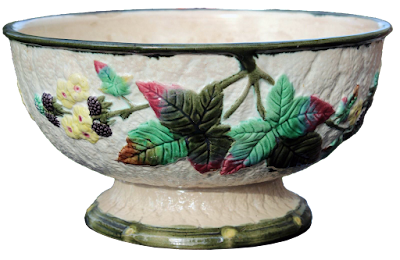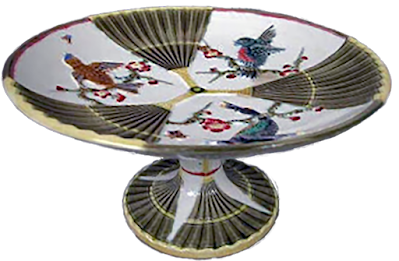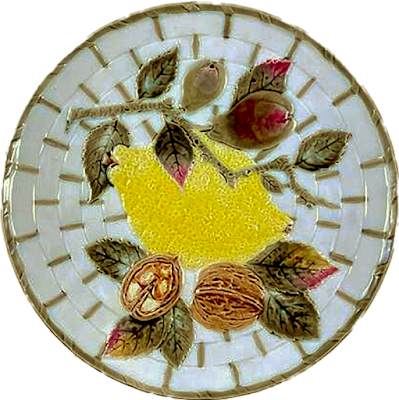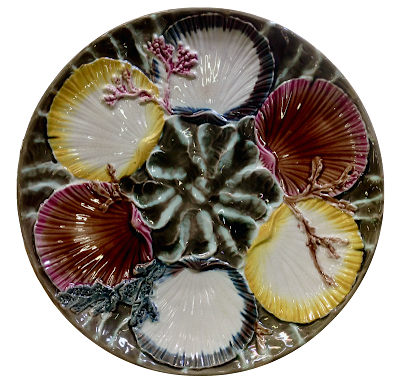Wedgwood Argenta Palm cheese bell
In 2010 I did a Majolica Spotlight post on Wedgwood's Argenta line of majolica. In it I tried to explain the difference between ware glazed in this color combination of glazes and other glaze combinations. There seems to still be some confusion about what that means. I think that maybe it's time to revisit the subject.
Wedgwood majolica Argenta Ocean salad set
The Wedgwood trade name ARGENTA is derived from the Latin word for silver, ARGENTUM. It's easy to see why this majolica color combination was named after this precious metal. As a combination of neutrals and pastels, the overall monochromatic impression that majolica glazed in this color combination gives is precisely what distinguished it from the vibrantly colored majolica that preceded it.
It should surprise no one that Argenta decoration was originally called "Silver" decoration by Wedgwood. It was changed to Argenta as a marketing ploy after its popularity increased with the Victorian buyer. The glaze color combination soon became popular with other manufacturers as well. Below is a description of Argenta from the November 1879 issue of Pottery & Glass Traders' Journal about Hackney's version of Argenta:
"Messrs. F. Hackney & Co., of Stoke, have recently been manufacturing some new umbrella stands. They are in the new Argenta ware, which is the nearest imitation to the colour of silver that can be produced in potting."
Hackney, and later their successor Fielding, named their ivory ground ware Argenta after the Wedgwood predecessor. Smaller English potters copied the look as well. American manufacturers Hayes and the Etruscan Works used the ivory ground, pastel glaze combination to great effect.
Hackney/Fielding majolica Argenta fox dish
Fielding majolica umbrella/cane stand in Argenta
Etruscan Majolica begonia cake plate glazed in Argenta colors
Argenta does not refer to any Wedgwood majolica decorated in colored grounds. It also does not refer to just any Wedgwood majolica with an ivory ground although it plays to a similar sensibility. Case in point below. The monkey plate in Argenta has a particular combination of glaze colors. The plate below it is just a monkey plate with a white ground. If the bottom piece had a different colored ground it would look like any other monkey plate. If the Argenta plate had a different colored ground it would look peculiar compared to other monkey plates.
Wedgwood majolica Argenta monkey plate
Wedgwood majolica monkey plate
Below are other ivory ground Wedgwood pieces that are not Argenta
Wedgwood majolica Hops ale set
Wedgwood majolica Panther vases
Wedgwood majolica Dragon tea set
Wedgwood majolica Mat platter
It may appear that I’m splitting hairs over this but if I’m going to define Argenta wares you should at least understand the term.
Wedgwood’s Fan pattern was by far their most popular Argenta line. While it was also glazed in other color combinations it was the Argenta coloration that dominated the company’s production of the pattern and is the most commonly found coloring today.
Wedgwood majolica Fan dessert stand
The glaze color combination became so popular that certain designs appear to have been largely only issued in Argenta. To date I have never seen the Wedgwood Bramble tea set in any color besides Argenta. I have seen the pitchers and jardinieres in other colors but never the tea set. The Tropic series of dessert wares is also very rarely found in full color.
Wedgwood Argenta Tropic pomegranate plate
What distinguishes Argenta is this dominating combination of taupe and rose with occasional spots of other colors. Green and brown are part of the Argenta color palette although not dominant. Other commonly seen colors are yellow, black, tan, olive, rose, grey and an occasional spot of blue. Turquoise is the dominant lining color in the hollowware. Still, it is the taupe glazes and ivory ground that distinguish Argenta as you can see from the examples below.
Wedgwood Argenta majolica Aesthetic Movement umbrella stand
Wedgwood majolica Argenta Chrysanthemum cheese bell
Wedgwood majolica Argenta game terrine
Wedgwood majolica Argenta fig plate
Wedgwood majolica Argenta orange plate
Wedgwood majolica Argenta pear plate
Wedgwood majolica Argenta pineapple plate
As I mentioned earlier. collectors today are attracted to majolica for its decorative color. Naturally, brightly colored pieces would get all the attention. Majolica is no longer seen as part of a larger dining experience where Argenta pieces would effortlessly fit in, hence Argenta's lack of popularity today. I find that unfortunate because Argenta has a timely modernity that brightly colored majolica lacks. It works well with contemporary decor for the simple reason that it doesn’t draw attention to itself but instead contributes to a larger whole effect.
Wedgwood majolica Argenta strawberry set
Wedgwood majolica Argenta dolphin oyster plate
Wedgwood majolica Argenta Ocean oyster plate
Wedgwood majolica Argenta Grosvenor oyster plate
Wedgwood majolica Argenta Daisy Flower Pot
Wedgwood majolica Argenta Mat platter
Wedgwood majolica Argenta St. Louis fish platter
Wedgwood majolica Argenta Pear plate
Wedgwood majolica Argenta Chrysanthemum oyster plate
Wedgwood majolica Argenta corn bread plate
Wedgwood majolica Argenta monkey teapot
Wedgwood majolica Argenta Early English plate
Wedgwood majolica Argenta Ocean plate
Because of the pale ground Argenta is particularly susceptible to bad staining but there is a solution for that. Cleaning majolica is very easy. All it requires is a few basic supplies and some patience.
So why, do you ask, should you buy Argenta? One of the main reasons is that, as a collector, you can find pieces that are otherwise impossible to find or afford in other colors. Besides that, a collection of all Argenta makes for quite a stunning display. After all isn't that why we collect pottery in the first place?






















































No comments:
Post a Comment